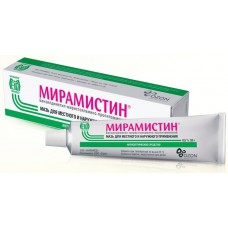Expiration date: 01/2025
Active substance:
100 g of ointment contains: Benzyldimethyl[3-(myristoylamino)propyl] ammonium chloride monohydrate (in terms of anhydrous substance) – 0.5 g
Auxiliary substances:
Disodium edetate – 0.5 g, poloxamer 338 – 5.0 g, macrogol 400 (Polyethylene oxide 400) – 16.1 g, macrogol 1500 (Polyethylene oxide 1500) – 20.0 g, macrogol 6000 (Polyethylene oxide 6000) – 9.0 g, propylene glycol - 45.9 g, purified water – up to 100.0 g
Description:
A homogeneous ointment of white or almost white color with a faint characteristic odor.
Release form:
Ointment for local and external use 0.5%. 30 g each in aluminum tubes with bushons. One tube together with the instructions for use is placed in a cardboard package (pack).
Contraindications
Hypersensitivity to the active substance and other components of the drug, pregnancy, breastfeeding, children under 18 years of age (no experience of use).
Dosage
5 mg/g
Indications for use
In surgery – in the 1st phase of the wound process – for the treatment of infected wounds of various localization and genesis (wounds after surgical treatment of purulent foci, bedsores, trophic ulcers, suppurated postoperative wounds, fistulas); in the 2nd phase of the wound process – for the prevention of reinfection of granulating wounds.
In kombustiology – for the treatment of superficial and deep burns of II–IIIA degree and frostbite, for the preparation of burn wounds for autodermoplasty.
In dermatology – for the treatment of strepto- and staphyloderma, candidiasis of the skin and mucous membranes, mycoses of the feet and large skin folds, including dyshydrotic forms and forms complicated by pyoderma, dermatomycosis of smooth skin.
For the prevention of complications of wound infection – in case of non-extensive industrial and household injuries.
Interaction with other medicinal products
Agents containing anionic surfactants (soap solutions) inactivate the drug. In the combined treatment of wounds, when the local use of the drug Miramistin® is combined with the systemic administration of antibiotics, the dose for the course of the latter can be reduced.
Overdose
Overdose of the drug has not been observed to date. However, when using the drug on an extensive wound surface in large quantities, it can penetrate into the systemic bloodstream, its effect will manifest itself as the action of a cationic detergent and may prolong the bleeding time.
Treatment: dose reduction or discontinuation of the drug, oral calcium preparations, sodium menadione bisulfite (vikasol) are prescribed.
Pharmacological action
Pharmacological group:
Antiseptic agent
ATX code. D08AJ.
Pharmacodynamics:
The drug Miramistin® contains in its composition the cationic antiseptic benzyldimethyl[3-(myristoylamino)propyl] ammonium chloride monohydrate, due to which it has an antimicrobial effect on gram-positive and gram-negative aerobic and anaerobic spore-forming and asporogenic microflora in the form of monocultures and microbial associations, including hospital strains with polyresistance to antibiotics. The drug is more effective against gram-positive bacteria (staphylococci, streptococci, etc.).
It has an antifungal effect on ascomycetes of the genus Aspergillus and the genus Penicillium, yeast (Rhodotorula rubra, Torulopsis glabrata) and yeast-like (Candida albicans, Candida tropicalis, Candida krusei) fungi, on dermatophytes (Trichophyton rubrum, Trichophyton mentagrophytes, Trichophyton verrucosum, Trichophyton schoenleini , Trichophyton violaceum, Epidermophyton Kaufman-Wolf, Epidermophyton floccosum, Microsporum gypseum, Microsporum canis), as well as other pathogenic fungi (for example, Pityrosporum orbiculare [Malassezia furfur]) in the form of monocultures and microbial associations, including fungal microflora with resistance to chemotherapeutic drugs. The drug Miramistin® reduces the resistance of bacteria and fungi to antibiotics. Thanks to a wide range of antimicrobial action, Miramistin® effectively prevents infection of wounds and burns, activating regeneration processes.
The drug has a pronounced hyperosmolar activity, as a result of which it stops wound and perifocal inflammation, absorbs purulent exudate and selectively dehydrates necrotic tissues, contributing to the formation of a dry scab. At the same time, the ointment does not damage granulations and viable skin cells, does not inhibit marginal epithelialization.
Pharmacokinetics:
Due to the physico-chemical properties of the ointment base, the drug Miramistin® acts not only on the superficial wound microflora, but also on pathogens located in the tissues surrounding the wound, which is why it is possible that a small part of benzyldimethyl-myristoyl-aminopropyl-ammonium chloride may enter the systemic circulation.
Pregnancy and breast-feeding
There is not enough experience in the use of ointment for the treatment of pregnant women and women during breastfeeding.
Conditions of release from pharmacies
Without a prescription
Side effects
Dryness and burning at the site of application, passing independently and not requiring the use of analgesics and the cessation of the use of ointment.
Special instructions
Due to the wide range of antimicrobial action, the ointment can be used for mixed bacterial and fungal infections, especially in the initial period of treatment, before the identification of the causative agents of the disease.
The effectiveness of the drug increases if it is applied to the wound surface, previously washed with an aseptic solution.
The presence of purulent-necrotic masses in the wound requires additional consumption of ointment.
Effect on the ability to drive vehicles, mechanisms:
The drug does not affect the ability to drive vehicles and mechanisms.
Storage conditions
Store at a temperature not exceeding 25 ° C. Keep out of reach of children.
Method of administration and dosage
Locally, externally.
After standard treatment of wounds and burns in adults, the drug is applied directly to the affected surface, after which a sterile gauze bandage is applied or ointment is applied to the dressing material, and then to the wound;
Tampons impregnated with the drug loosely fill the cavities of purulent wounds after their surgical treatment;
Gauze turunds with ointment are injected into the fistula passages.
In the treatment of purulent wounds and burns in the 1st phase of the wound process, the drug is used 1 time a day, in the 2nd phase - 1 time from one to three days, depending on the condition of the wound. 2-4 g of ointment (strip – 1-2 cm) is applied in a thin layer on gauze napkins, applying the latter to wounds with a 2-3 cm approach to undamaged areas in the circumference of the wound with a daily change of bandages. The duration of treatment is determined by the dynamics of cleansing and healing of wounds. With deep localization of infection in soft tissues, it is possible to use the drug together with systemic antibiotics, while the duration of treatment will be determined by the duration of the course of taking the antibiotic.
In the treatment of dermatological diseases in adults, the drug is applied with a thin layer to the damaged areas of the skin several times a day or impregnated with a gauze bandage with its subsequent application to the lesion 1-2 times a day until negative results of microbiological control are obtained.
With common dermatomycosis, in particular with rubromycosis, the ointment can be used for 5-6 weeks in combination therapy with griseofulvin or antifungal drugs of systemic action.


